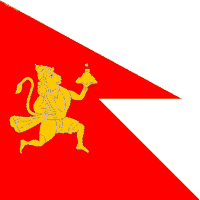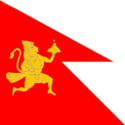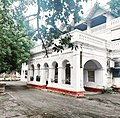
The Central India Agency was created in 1854, by amalgamating the Western Malwa Agency with other smaller political offices which formerly reported to the Governor-General of India. The agency was overseen by a political agent who maintained relations of the Government of India with the princely states and influence over them on behalf of the Governor-General. The headquarters of the agent were at Indore.

Dewas is a city in the Malwa region of the Indian state of Madhya Pradesh. The municipality was formerly the seat of two 15-Gun Salute state princely states during the British Raj, Dewas Junior state and Dewas Senior state, ruled by the Pawar clan of the Marathas. The city is the administrative capital of Dewas district. Dewas is an industrialised city and houses a government bank note press.

The Holkars were the ruling house of the Indore State of the Maratha Confederacy, and earlier held the rank of subahdar under Peshwa Baji Rao I. When the Maratha Confederacy began to weaken due to internal clashes, the Holkars declared themselves the rulers of Indore in Central India, existing as an autonomous member of the Maratha Confederacy until 1818. Later, their kingdom became a princely state under the British protection.
Pawar is an Indian surname found among the Maratha, Mahar or Koli people in Maharashtra.

Dewas District is a district in the Indian state of Madhya Pradesh. The town of Dewas is the district headquarters. It belongs to Ujjain Division.

The Battle of Mahidpur was fought during the Third Anglo-Maratha War between the Indore State of the Maratha Confederacy and the British East India Company at Mahidpur, a town in the Malwa region, on 21 December 1817.
Malwa Agency was an administrative section of British India's Central India Agency. The headquarters of the political agent was at Neemuch (Nimach). The other chief towns of the region were : Ratlam and Jaora.

The Gwalior State, initially the Ujjain State, was a state within the Maratha Confederacy located in Central India. It was ruled by the House of Scindia, a Hindu Maratha dynasty. Following the dissolution of the Confederacy, it became part of the Central India Agency of the Indian Empire under British protection.

The Daly College is a group of institutions consisting of a co-educational private boarding, day school, a private junior school, an undergraduate management school and a postgraduate business school, located in Indore, Madhya Pradesh, India. It was founded by Sir Henry Daly of the British Indian Army during India's colonial British Raj, following an English public school model. The school started in 1870 as the Residency School. It was then renamed as the East Rajkumar College in 1876, and in 1882, it came to be known as The Daly College. It was established by the Resident Governor of the erstwhile Presidency, to educate the children of the royalty, nobility and aristocracy of Central Indian Princely States of the 'Marathas', 'Rajputs', 'Mohameddans' and 'Bundelas'. It is one of the oldest co-educational boarding schools in the world.

Dhar State was a princely state. It was a salute state in the colonial sway of the Central India Agency. Dhar began as one of the states during Maratha dominance in India about 1730. In 1941 it had an area of 1,798 square miles (4,660 km2) and a population of 253,210. Dhar was the capital of the state since 1732 (from the 1728 foundation, the Raja's first seat had been at Multhan in Dhar district. In 1948, it became part of Madhya Bharat.
Krishnajirao III, belonging to the Puar dynasty of the Marathas, was the third and last reigning Maharaja of Dewas State (senior), reigning from 23 March 1947 to 27 June 1948. The only son of Sir Vikramsinhrao, Maharaja of Dewas, he was 15 years old when his father abdicated to become Chhatrapati Shahaji II Bhonsle, Maharaja of Kolhapur. As such, he ruled Dewas under the regency of his mother, Maharani Pramilabai for the brief time between his succession and Indian independence on 15 August 1947. On 27 June 1948, Dewas and other Maratha kingdoms merged to form the Madhya Bharat Union. Derecognised by the Government of India in 1971 as a ruler, he lived a quiet life until his death at the age of 66 on 21 January 1999. He was succeeded by his only son, Tukojirao IV.

Jath State, was one of the non-salute Maratha princely states of Deccan States Agency, one of the former Southern Maratha Jagirs. Jath State and Daphlapur State were the only two states belonging to the Bijapur Agency under the Bombay Presidency, which later became part of the Deccan States Agency.

Rao Nandlal Chaudhary was a Gaur Brahmin and the chief of the Zamindars of Kampel, near Indore. Under the suzerainty of the Mughals, he controlled Kampel and some of its surrounding area including Indore. He accepted the suzerainty of the Marathas, after the Nizam acceded to the Peshwa's demands in 1724.

The following list includes a brief about the titles of nobility or orders of chivalry used by the Marathas of India and by the Marathis/Konkanis in general.

Dewas Junior was established by Jivaji Rao I Puar in 1728 during the Maratha conquest of Central India. It was a 15-gun salute Maratha princely state. On 12 December 1818, it became a British protectorate.

Dewas Senior was established by Tukoji Rao I Pawar during the Maratha conquest of Central India. It was a 15 Gun Salute Maratha princely state. On 12 December 1818 it became a British protectorate.

Indore State was a principality within the Maratha Confederacy ruled by the Maratha Holkar dynasty. After 1857, Indore became a 19-gun salute princely state within the Central India Agency of the Indian Empire under British protection.

Hemendra Singh Rao Pawar, was the titular Maharaja of Dhar State. He was a descendant of the Pawar (Puar) dynasty that ruled Dhar State.
Vikram Singh Rao II Puar, is the present titular and the 10th Maharaja of Dewas Senior. He is a descendant of the Maratha Puar (Pawar) dynasty. He ascended the 'Gadi' of Dewas Senior as the Maharaja, after the death of his father late HH Maharaja Tukoji Rao IV Puar at the Anand Bhawan Palace, Dewas. His mother Gayatri Raje Puar represents Dewas in Madhya Pradesh assembly, having won the election in 2018.

























